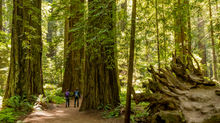Don't Let Your Tripod Control Your Shot
I've noticed at recent workshops, that when it comes to landscape photography there is tendency for people to pull out their tripods, extend the legs all the way, and then start shooting. While this may be fine for some shots, it is possible that a better perspective may be available by getting a little, or in some cases a lot lower.
What are some things that need to be considered? For me, the first thing I look at is the relationship between the various objects in my frame. Do I have separation? In the following image taken along the north shore of Lake Superior, I wanted to make sure that the snow covered rocks provided a nice path out to the point.

For this shot I needed to be as high as I could. In fact, I even extended the center post slightly just add a bit more height. If I had lowered my camera, the rocks in the foreground would have blocked out the ones behind it. In addition, most of the shadows would have been lost making the shoreline lose much of its texture.
Later on the same day, I came across some ice formations that were on top of some old dock pilings. In this case, I wanted to really emphasize the ice formation, but also wanted to give a sense of place to the location. If I set my tripod up, fully extended, I get the following shot:

We can see that the piling gets somewhat lost in the image. Other than being a foreground element it really does not add much. What I really wanted was to emphasize the ice forming on the piling, and give it a sense of place. I repositioned to another piling, and instead placed the camera really low. The result was the following:

I like this image much better. The interest is drawn to the ice on the piling, and at the same time, there is a nice landscape filling in the background.
The question is, how do you determine the proper height? Obviously this will vary based on the scene. My approach is to evaluate the scene in the following way:
What feature or features am I looking to emphasize?
What detail do I want to have in my photo?
Do I have elements of the photo overlapping?
What focal length am I shooting at?
All of these questions play a role in the height of the camera. Notice in the above image, the top of the piling is just below the level of the horizon. This is important for adding depth to the image, When I set up this shot, I paid close attention to the relationship between the piling and the horizon.
The last point is about focal length. The longer the focal length, the more I need to be concerned with having elements in the foreground or the background out of focus. An easy way to deal with that is to raise up the camera in order to remove some of the foreground. Consider the following image.

For this image, I wanted to shoot at 50mm. Why 50mm? On a full frame sensor, 50mm is close to how the human eye perceives a scene. At 50mm, the hyperfocal point is 12.2 feet into the scene. The problem is that the first 6 feet will be out of focus because the near limit is 6.1 feet. If I have the camera too low, then some of the rocks in the foreground will be soft. If I go too high, then the rocks lose too much of their detail. For this shot I needed to be somewhere in the middle. I set the tripod at about 2/3rds of it's height and took the shot.
If you would like to learn more about landscape photography including how to photography waterfalls, I have a couple of great opportunities coming up. On March 18th, 2017, Alan Boucher and I will be teaching a class at the Dow Gallery in St. Paul on Landscape and Waterfall photography. You can find out more information at http://www.frozenhiker.com/waterfalls-and-landscapes. For a more in-depth experience, join us for our weekend workshop along the north shore along Lake Superior the first weekend in June. More details can be found at http://www.frozenhiker.com/spring-workshop.
#compositiontechniques #parks #composition #photocomposition #landscapephotography #landscape #winter #winterphotography #rocks #ice #LakeSuperior #Minnesota #NorthShore #tripod #photographytechniques #photographytips #photographytutorial #naturephotography #shoreline #shorelinephotography #hyperfocal #landscapetechniques



































